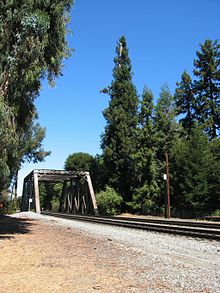
Back El Palo Alto German El Palo Alto Spanish El Palo Alto French El Palo Alto Italian ꯑꯦꯜ ꯄꯥꯂꯣ ꯑꯜꯇꯣ MNI El Palo Alto Romanian El Palo Alto Swedish 埃尔帕洛阿尔托 Chinese

El Palo Alto (Spanish: 'the tall stick'[1]) is a coast redwood (Sequoia sempervirens) located on the banks of the San Francisquito Creek in Palo Alto, California, a city in the San Francisco Bay Area. The namesake of the city and a historical landmark, El Palo Alto is 1083–1084 years old and stands 110 feet (34 m) tall.
Before European arrival, the land around El Palo Alto was home to the Ohlone Native Americans. Local folklore holds that El Palo Alto was a rest stop for the first European expedition that discovered San Francisco Bay, led by Spanish explorer Gaspar de Portolá in 1769. The tree became widely known with the early-1850s establishment of a highway between San Francisco and San Jose, and as a landmark along the San Francisco–San Jose railroad, construction of which passed the tree in 1863. In 1876, Leland Stanford, co-founder of Stanford University along with his wife Jane Lathrop Stanford, purchased land near El Palo Alto.[2]
Early images and accounts indicate that El Palo Alto once had two trunks. It lost one trunk before 1883—the exact date is unknown—perhaps due to heavy rainfall and erosion of the riverbank. Fearing the tree's total loss, Leland Stanford directed that the riverbank be reinforced with a wooden bulkhead, which was replaced with concrete abutments in 1904 and again in 1911. Train soot suffocated the leaves of the tree's upper limbs, nearby wells lowered the water table, and by the late 1920s the tree was declared moribund. Although it has decreased in stature by some 50 ft (15 m) since the late 1800s, El Palo Alto was ultimately saved by the continuous preservation efforts of the city, local arborists, Stanford University, and Southern Pacific (the owner of the adjacent railroad); a 1997 appraisal concluded that the tree would "persevere and grow for centuries to come". El Palo Alto is featured prominently on the City of Palo Alto logo and the Stanford University seal, and is recognized by the National Arborist Association and International Society of Arboriculture as a tree of historical importance.
- ^ Robbins, Jim (June 26, 2021). "The Unlikely Survival of the 1,081-Year-Old Tree That Gave Palo Alto Its Name". The New York Times. Archived from the original on June 26, 2021. Retrieved September 17, 2022.
- ^ "Stanford (Jane Lathrop) Papers". oac.cdlib.org. Retrieved April 16, 2023.
© MMXXIII Rich X Search. We shall prevail. All rights reserved. Rich X Search